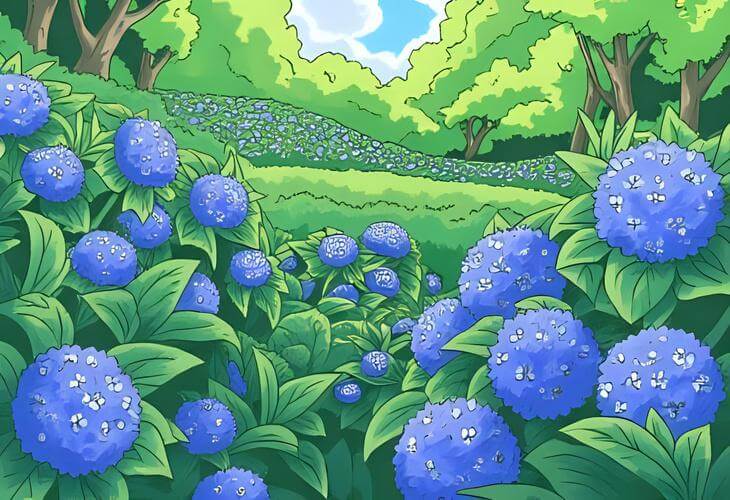
Borage (Borago officinalis), often called “starflower” for its dazzling blue, five-pointed blooms, is a popular annual herb known for its edible flowers, cucumber-flavored leaves, and reputation as a top-tier pollinator plant. With its fuzzy stems, vivid blossoms, and ability to self-seed easily, borage is popular with gardeners and beneficial to insects.
Native to the Mediterranean region, borage has naturalized in many parts of the U.S. It grows rapidly, thrives in average soil, and flowers profusely from late Spring through Summer. Borage is a classic companion plant, improving pollination for nearby crops like tomatoes, squash, and strawberries.
Soil (pH) Requirements
Borage is highly adaptable and not picky about soil. That said, it grows best in well-drained soil with a slightly acidic to neutral pH—typically between 6.0 and 7.0.
Tips for Soil Success
- Work in compost or aged manure before planting for strong early growth.
- Avoid heavy clay soils or poor drainage, which can cause root issues.
- Borage is drought-tolerant once established but prefers soil that retains some moisture.
Sun Requirements
Borage thrives in full sun, needing six to eight hours of direct sunlight daily to flower abundantly and produce strong stems.
Placement Suggestions
In cooler climates, plant in the sunniest spot available.
In hot climates, borage appreciates some light afternoon shade to protect its delicate blooms and foliage from scorching.
Watering Requirements
Though borage is somewhat drought-tolerant, consistent watering ensures lush foliage and continuous blooms.
Watering Tips
- Keep the soil moderately moist, especially while plants are young.
- Water at the base of the plant to prevent leaf disease.
- Once established, borage requires less frequent watering but benefits from deep soakings during dry spells.
Best Plant Hardiness Zones
Borage grows as an annual in most climates but can self-seed prolifically, allowing it to return year after year.
Suitable for USDA Zones 2–11
In frost-free Zones 9–11, borage may behave more like a short-lived perennial.
Sow directly in the garden after the last frost; borage doesn’t transplant well due to its long taproot.
Borage’s Versatility and Pollinator Appeal
Borage’s appeal goes far beyond its striking blue blossoms. It’s treasured for its culinary, medicinal, and ornamental value:
- The flowers are edible, adding beauty and a cucumber-like freshness to salads, cocktails, and desserts.
- Leaves are used sparingly in herbal teas and cold drinks.
- Borage attracts beneficial insects and improves pollination for neighboring vegetables.
Most notably, borage is a magnet for pollinators, especially:
- Honeybees, which adore its nectar-rich flowers
- Bumblebees, thanks to its accessible bloom structure
- Hoverflies, which help manage aphids and other pests
- Butterflies, which flutter from bloom to bloom in warm weather
Borage produces continuous nectar, even in hot and dry conditions, making it one of the most reliable plants for pollinator support throughout the Summer.
Five Beautiful and Beneficial Borage Varieties
Common Borage (Borago officinalis)
The standard variety, this borage is the most widespread and easily recognizable, with bright sky-blue, star-shaped flowers and rough, hairy leaves. It can grow up to 3-feet tall and spreads quickly in open beds.
Popular Uses
- Pollinator beds and vegetable garden borders
- Fresh flowers for salads or frozen into ice cubes
- Herbal remedies and bee forage
Pollinator Note: A top nectar plant for honeybees and bumblebees, particularly in midsummer when other food sources may decline.
Best Zones: 2–11
White Borage (Borago officinalis Alba)
This elegant twist on the classic features creamy white flowers while maintaining the same structure and benefits of standard borage. It offers a subtle, calming effect in herb and flower gardens.
Popular Uses
- Soothing, monochrome garden designs
- Contrast against darker-leaved companions
- Culinary uses where blue hues aren’t preferred
Pollinator Note: Just as attractive to bees and butterflies as its blue cousin, and the white flowers stand out in dusk and early morning light.
Best Zones: 3–9
Creeping Borage (Borago pygmaea)
Unlike tall upright types, this lesser-known species has a sprawling, ground-hugging habit, making it ideal for borders and containers. It has smaller flowers and is slower growing than common borage.
Popular Uses
- Ground cover or cascading from raised beds
- Pollinator-friendly rock gardens
- Gentle filler in flower borders
Pollinator Note: Offers a low-foraging platform for hoverflies and small native bees, especially useful in mixed flower beds.
Best Zones: 6–10
Pink Borage (Occasional natural hybrid or mutation)
While not widely available as a seed variety, pink borage blooms sometimes appear as natural variations among blue borage plants. These unique flowers bring a sweet, unusual touch to the garden.
Popular Uses
- Romantic or pastel garden palettes
- Garden photography and novelty beds
- Flower garnishes with unexpected flair
Pollinator Note: Just as nectar-rich as blue blooms, pink borage flowers still attract honeybees, hoverflies, and butterflies, especially skippers.
Best Zones: 3–9 (when seeds can be sourced)
Trailing Borage (Container-Grown Selections)
Some commercial growers have developed borage strains specifically bred for compact growth and trailing habits, ideal for containers and hanging baskets. These hybrids maintain the same bright flowers and herbal value.
Popular Uses
- Balcony or urban gardens
- Pollinator pots on patios
- Portable bee-feeding stations
Pollinator Note: A portable buffet for solitary bees and urban pollinators, especially valuable where space is limited but pollinator support is needed.
Best Zones: 4–10


 Previous
Previous

